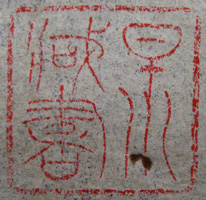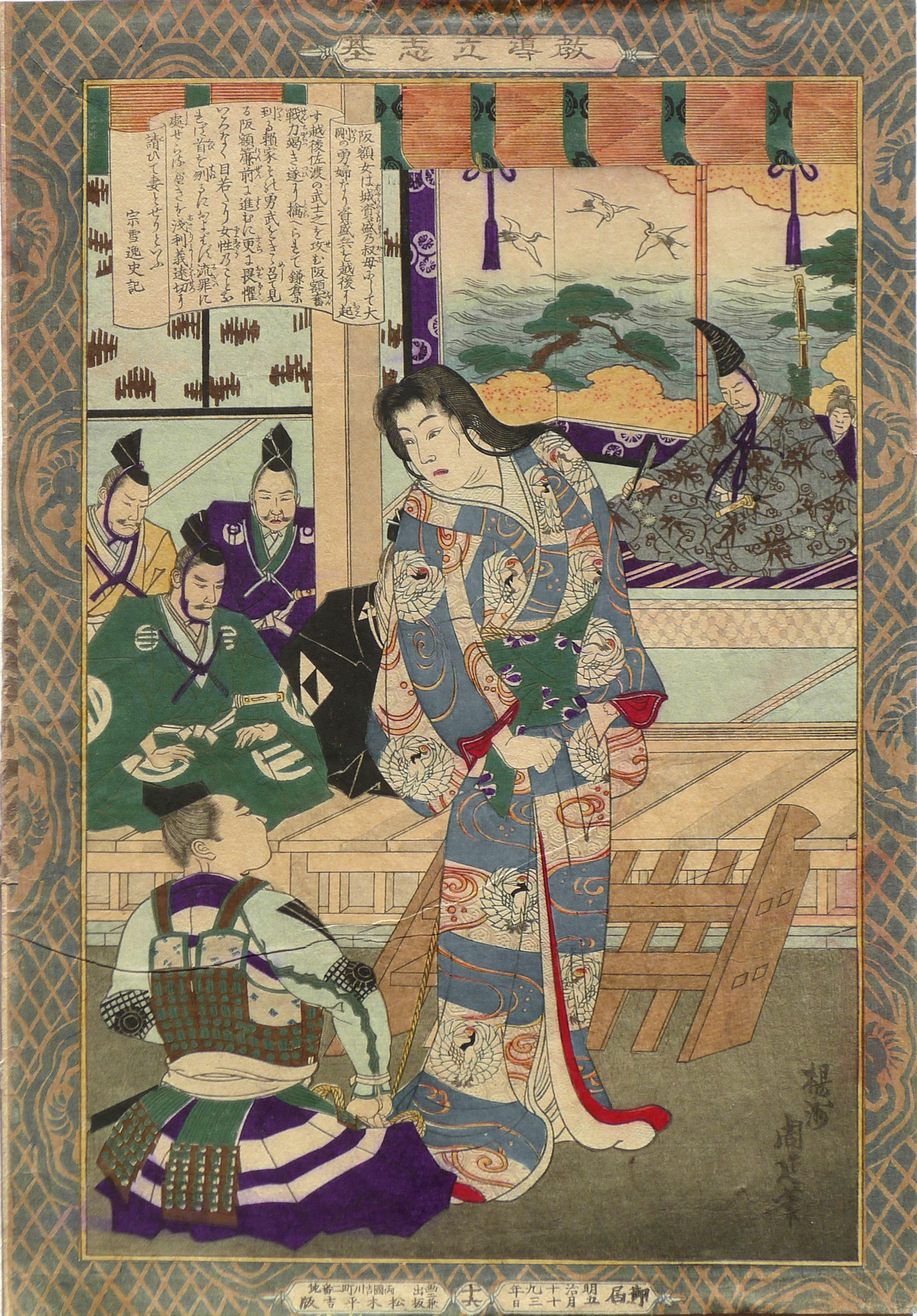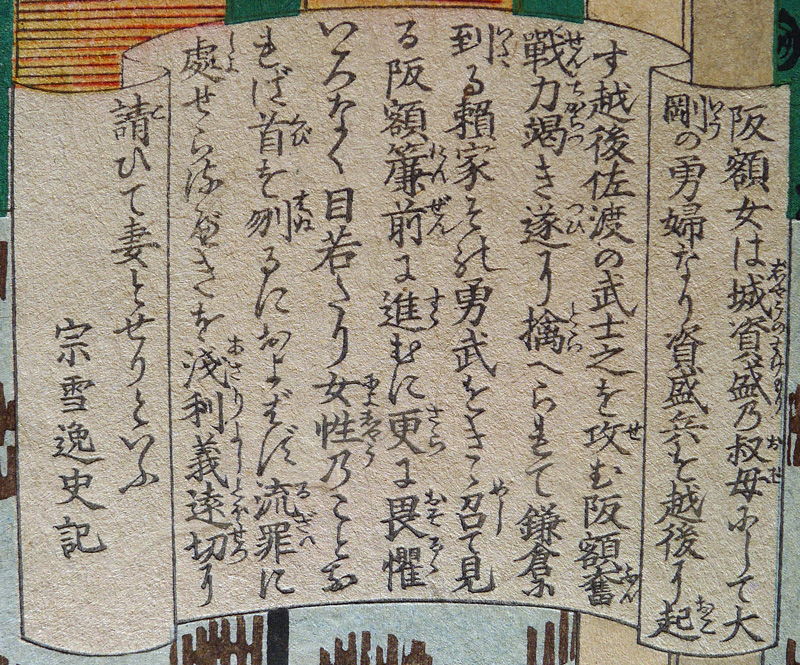About This Print
Print number 16 (十六)1 in the series Instructive Models of Lofty Ambition picturing the female warrior Hangaku-jō after her capture being introduced to the warrior Yoshitō, seated before her, whom she later married.This print is one of two created by Chikanobu for the series, although his name is not listed among the artists appearing on the Table of Contents sheet. [See IHL Cat. 1071.)
1 Numbers were used a bit haphazardly on the prints, with many prints bearing no numbers and some prints displaying numbers on some impressions and not on others. In addition, the same prints can be found bearing different numbers. When print numbers are shown on the print they sometimes do not agree with the placement of their title in the Table of Contents, as is the case with twelve prints, and some print titles that are listed in the Table of Contents do not show a print number on the print, as is the case with seven prints.
The Story of the Hangaku
Source: wikipedia http://en.wikipedia.org/wiki/Hangaku_GozenHangaku was a female warrior of the Jō, allies of the Taira clan during the end of the Hein and the beginning of the Kamakura periods. In 1201, together with her nephew Jō Sukemori, she raised an army in response to Sukemoto's attempt (the Kennin Uprising) to overthrow the Kamakura Shogunate. Hangaku and Sukenaga took a defensive position at a fort at Torisakayama under attack from Sasaki Moritsuna. Hangaku commanded 3,000 soldiers to defend against an army of 10,000 soldiers loyal to the Hōjō clan.
Ultimately she was wounded by an arrow and captured; the defenses then collapsed. Hangaku was taken to Kamakura. When she was presented to the shogun Minamoto no Yoriie, she met Asari Yoshitō, a warrior of the Kai Genji, who received the shogun's permission to marry her. They lived in Kai, where she is said to have had one daughter.
Transcription of Scroll
Source: with thanks to Yajifun http://yajifun.tumblr.com/
教導立志基 十三 阪額女 揚州周延 1886年5月13日
“阪額女は城資盛の伯母にして大剛の勇婦なり 資盛兵を越後に起す 越後佐渡の武士之を攻む 阪額奮戦 力竭(ちからつ)き遂に擒(とら)へられて鎌倉に到る 頼家その勇武をきゝ召て見る 阪額簾前に進むに更に畏懼(おそるゝ)いろなく目若たり 女性のことなれば首を刎るにおよばず流罪に處せらるべきを浅利義遠切に乞ひて妻とせりといふ 宗雪逸史 記”
※阪額の大きな画像がやっと見つかった。リンク先は IE じゃないとエラーが出るかもしれない。
About The Series "Kyōdō risshi no motoi"
Notes:1. This series is variously translated as "Instructive Models of Lofty Ambition," "Foundations of Learning and Achievement," "Foundation of Instruction and Perseverance," "Self-Made Men Worthy of Emulation," "Paragons of Instruction and Success," "Moral of Success," "Examples of Self-Made Leaders," and "Instruction in the Fundamentals of Success." The title in Japanese is sometimes seen as "Kyōdō risshiki or "Kyōdō risshi no moto," in addition to the most commonly seen transliteration of "Kyōdō risshi no motoi".
2. For a complete listing of all the prints in the series and additional information please see the article on this site titled Instructive Models of Lofty Ambition.
This series ran between October 1885 and November 1890 and featured a long list of heroes and heroines, from antiquity to contemporary times, who were regarded as standards of moral leadership and self-realization.
Source: Kiyochika Artist of Meiji Japan, Henry D. Smith II, Santa Barbara Museum of Art, 1988, p. 74-75; original research and as footnoted.
This series of 58 prints,1 plus a table of contents sheet (目録), were originally published between October 1885 and November 1890 by the Tokyo publisher Matsuki Heikichi 松木平吉.2 The table of contents sheet issued by the publisher states that "fifty prints make up the complete set (五十番揃)". Three prints not in the initial release were added over the five year publication period, as were five redesigns of original prints, eventually increasing the total print count to 58. The seven artists contributing prints were Kobayashi Kiyochika (1847-1915) [20 prints], Mizuno Toshikata (1866-1908) [16 prints], Inoue Tankei (Yasuji) (1864-1889) [13 prints], Taiso (Tsukioka) Yoshitoshi (1839-1892) [5 prints], Yōshū Chikanobu (1838-1912) [2 prints], Toyohara Kunichika (1835–1900) [1 print], and Hachisuka (Utagawa) Kuniaki II (1835-1888) [1 print]. All the artists, with the exception of Yōshū Chikanobu, are listed in the top scroll of the table of contents sheet. Various colors (including blue, blue/green, and tan/brown) were used for the decorative border, and in 1902 the series was re-issued by Matsuki without borders.
This series of 58 prints,1 plus a table of contents sheet (目録), were originally published between October 1885 and November 1890 by the Tokyo publisher Matsuki Heikichi 松木平吉.2 The table of contents sheet issued by the publisher states that "fifty prints make up the complete set (五十番揃)". Three prints not in the initial release were added over the five year publication period, as were five redesigns of original prints, eventually increasing the total print count to 58. The seven artists contributing prints were Kobayashi Kiyochika (1847-1915) [20 prints], Mizuno Toshikata (1866-1908) [16 prints], Inoue Tankei (Yasuji) (1864-1889) [13 prints], Taiso (Tsukioka) Yoshitoshi (1839-1892) [5 prints], Yōshū Chikanobu (1838-1912) [2 prints], Toyohara Kunichika (1835–1900) [1 print], and Hachisuka (Utagawa) Kuniaki II (1835-1888) [1 print]. All the artists, with the exception of Yōshū Chikanobu, are listed in the top scroll of the table of contents sheet. Various colors (including blue, blue/green, and tan/brown) were used for the decorative border, and in 1902 the series was re-issued by Matsuki without borders.
Brief texts contained within a scroll-like cartouche appearing on each print provide historical details. The scroll composer's name is given at the end of the scroll text. The “lofty ambition” of the title is a Confucian concept, originally from Mencius, meaning “righteous determination that would inspire others.” The market for the series probably included former samurai, ambitious youth, and conservative intellectuals.
"[W]hen it was completed in 1890 the publisher was singled out for special recognition by the government for having sponsored such noble subject matter."3
1 The Tokyo Metropolitan Library online collection shows 50 prints and a Table of Contents sheet. The Table of Contents lists the titles of 50 prints. Smith in Kiyochika Artist of Meiji Japan identified 52 prints. I have identified 58 prints from this series including five prints (Ikina, Michizane Sugiwara, Kesa Gozen, Soga Brothers and Hokiichi Hanawa) that were re-designed and re-printed, likely due to damaged or lost blocks.
2 Robert Schaap notes in Appendix II, p. 166 of Yoshitoshi, Masterpieces from the Ed Freis Collection, Chris Uhlenbeck and Amy Reigle Newland, Hotei Publishing, 2011 that the series originally appeared as newspaper supplements.
3 The World of the Meiji Print: Impressions of a New Civilization, Julia Meech-Pekarik, Weatherhill, 1986, p. 122.
Print Details
| IHL Catalog | #840 |
| Title or Description | Hangaku-jō 阪額女 |
| Series | “Instructive Models of Lofty Ambition” (Kyōdō risshiki 教導立志基) [note: series is variously translated as "Instructive Models of Lofty Ambition," "Foundations of Learning and Achievement," "Foundation of Instruction and Perseverance," "Self-Made Men Worthy of Emulation," "Paragons of Instruction and Success," "Moral of Success," "Examples of Self-Made Leaders," and "Instruction in the Fundamentals of Success."] |
| Artist | Yōshū Chikanobu (1838-1912) |
| Signature |  Yōshū Chikanobu hitsu |
| Seal | no seal |
| Publication Date | May 13, 1886 明治十九年五月十三日 |
| Publisher | Matsuki Heikichi (松木平吉) proprietor of Daikokuya Heikichi [Marks: seal not shown; pub. ref. 029] |
| Impression | excellent |
| Colors | good |
| Condition | fair - trimmed to image; reddish discoloration in brocade border; repair along left brocade border; fold in paper in lower left quadrant - more noticeable on photographic image than actual print; not backed |
| Genre | ukiyo-e; rishki-e; kyōiku nishiki-e |
| Miscellaneous |  (The upper left character could perhaps be 減, possibly pronounced "gen". Characters on the right are 早川 (Hayakawa.) Possibly a collector seal. |
| Format | vertical oban |
| H x W Paper | 13 7/8 x 9 1/4 in. (35.2 x 23.5 cm) |
| H x W Image | 12 3/8 x 8 1/8 in. (31.4 x 20.6 cm) area inside brocade border |
| Literature | |
| Collections This Print | Shizuoka Prefectural Central Library K915-108-045-031 |



